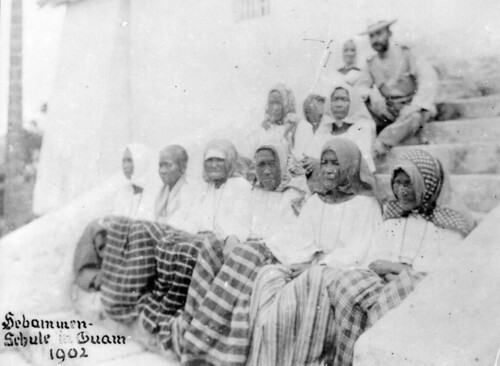Editor’s note: The following was adapted from The Pattera of Guam: Their Story and Legacy written by Karen A. Fury Cruz which was made possible, in part, from the Guam Humanities Council in cooperation with the National Endowment for the Humanities.
Transition to physician medical care
A significant change in the use and availability of nurse-midwives occurred in the 1950s and 1960s. The shift away from midwife-assisted home births to hospital births was apparent during this time. By 1951, an increase in the number of hospital births was reported; however, midwives were still receiving some training to assure adequate care in the home setting. Medical statistics indicate that twenty-eight midwives were in private practice in 1952.
In 1953, the first year after the enactment of the “Nurse Practice Act,” which established new licensing requirements, twenty-one certified midwives and three partially trained midwives were working for the government. None were employed in the private sector.
Birth certificate records of the Office of Vital Statistics did not begin indicating, until March 1955, whether the child’s birth had been attended by a midwife or a physician. In the subsequent ten months of that year, nineteen midwives had certified 284 births as being attended by midwives. This number was about fifteen percent of the 2,105 total number of births.
In 1956, the same year that the Guam Memorial Hospital facility opened in Tamuning, there were twenty registered midwives practicing in villages on Guam.
The government reported that in 1953, 45 percent of the births in Guam were attended by midwives, as compared with 2.6 percent of the births reported in 1964. The birth records for 1955 and 1960 show that the number of midwife-assisted births decreased from an estimated 15 percent of the total number of births in 1955 to 8 percent in 1960. In 1967, there were only nine midwife-assisted births, and all were reported by the same midwife. The last midwife license from that era expired in 1967. The practice of giving birth in a hospital continues on Guam today.
Despite the nurse-midwives’ creditable record of services, their role in assisting with home births in Guam has disappeared, owing to a combination of factors such as development of the US medical care model, the end of midwifery training, new licensure requirements, increased numbers of physicians, and the opening of new hospital facilities. The focus of the birthing process shifted away from families and home to an institutionalized medical setting.
Cars, cash economy changed birthing practices
This shift may also have been due to an increased access to cash by Chamorros, who in the prewar era were primarily farmers with little cash to spare. After the war, especially with the US military seizure of vast tracts of farmland, Chamorros were forced into the cash economy, finding jobs easily with the military as they began massively militarizing Guam.
In the prewar years, one of the major reasons women went to their pattera instead of the doctors at the Susana Hospital was financial, and thus, the removal of these financial constraits made it possible for more women to seek out hospital services.
There’s a lot to be said about modernity and the hospital being viewed as a provider of “modern” health care in the post-war context. After the war, Chamorros expressed a patriotism to the US that was unprecedented before the war, and especially after the granting of US citizenship, Chamorros sought out numerous ways to express their loyalty to the USA, including going to the hospital. In the context of liberation and new feelings of pride regarding Guam’s place in the US, Chamorros found ways to demonstrate their “belonging,” including seeking out all that was “modern.”
Increased access to cars was also an important factor in promoting the hospital’s use. After all, if one’s transportation was a carabao cart (as it was for most people before 1950), then during labor, the prospects of riding a carabao cart to a hospital were not well-received. Having
someone come to your house was instead a preferable alternative.
Nurse midwives used again
Staff of the Guam Board of Nurse Examiners reported in December 1996 that the Board had issued licenses to nine nurse-midwives, one of whom is a Chamorro woman who trained in the United States. The board estimates that about six nurse-midwives are presently practicing in Guam, all at large, private clinic settings. Some of these nurse-midwives also assist with births at the hospital. In 1993, an estimated 9 percent of the births at Guam Memorial Hospital were attended by nurse-midwives. This percentage has probably increased since 1993, but data are not available to verify this assumption. The recent increase in the demand for nurse-midwives is attributable to two factors: medical care organizations are seeking ways to lower the cost of medical care and to offset a shortage in the number of physicians who have a specialty in obstetrics.
A renewed parental interest in making childbirth more family oriented should create an even greater demand for a new generation of nurse-midwives who can bridge the gap between medical ideologies and the desired family-centered birthing event.
By Karen A. Fury Cruz, RN, MPH
Film
For further reading
DeLisle, Christine Taitano. Placental Politics: CHamoru Women, White Womanhood, and Indignity under US Colonialism in Guam. Chapel Hill: University of North Carolina Press, 2022.
Guevara, Claudia. “I Pattera.” Glimpses of Guam 15, no. 3 (1975): 60-63.
Haddock, Robert L. A History of Health on Guam. Hagåtña: Cruz Publications, 1973.
Hattori, Anne Perez. Colonial Dis-ease: U.S. Navy Health Policies and the Chamorros of Guam, 1898-1941. Pacific Islands Monograph Series 19. Honolulu: University of Hawai’i Press, 2004.
US Navy Department. Information on Guam Transmitted by the United States to the Secretary-General of the United Nations. OPNAV-P22-100G. Washington, DC: OPNAV, 1949.



